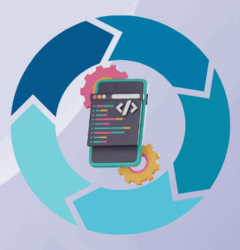
This article was first published on Customer think.
Depending on the industry, “digital transformation” might signify many things. Delivering customer-facing mobile experiences may be a priority for certain businesses as they modernize their core systems to increase efficiency.
A digital transformation journey, however, is a complex procedure with a beginning and an end. Instead, it’s a continual journey where IT leaders must constantly modify their business models, goods, and services to meet changing market demands, technological advancements, and customer expectations.
With a conflict in Europe, supply chain disruptions, a cost management strategy, and an inevitable economic downturn, 2023 looks challenging. However, IT leaders must recognize their digital transformation and innovation plan and stay caught up to rivals and suffering severe effects from the recession.
To assess if you’re making the correct investments, I’ll give views on what a successful digital transformation journey should entail in this blog post, considering the uncertainties the upcoming few months hold. I’ll also emphasize how utilizing the proper technology might enable you to succeed in the forthcoming cycle and meet your business objectives.
Why Digital Transformation seems challenging to organizations?
The challenges to digital transformation are essentially the same regardless of their industry or their difficulties that year, whether it be a recession, a public health crisis, or a new disruptive technology like mobile or the cloud.
Insufficient resources
IDC predicts that the 10% IT skills gap from 2021 will increase to 20% by 2025. Additionally, most top talent is taken up by innovative, elite software giants that can provide competitive pay and more alluring development jobs, leaving the “ordinary company” struggling to draw in and keep talent.
Huge backlogs
Organizations are pressured to become “software producers” and provide clients with distinctive and differentiating goods, which strains their IT departments. And as we can see from the rising need for internal employee experiences, this trend only seems to worsen. In fact, according to Gartner, CEO’s strategic priorities for CX have been eclipsed by employee experiences.
Technical debt
According to IDC, less than half of the legacy programs used in a company have been integrated with modern development tools, such as DevOps toolchains and integrated development environments. When businesses strive to innovate, they either integrate these outdated systems or create new programs, which may be tricky and expensive, adding to the technical debt.
Uncertainty
Genuine innovation is far from the relative safety of gradual and linear company improvement, which is why digital transformation is difficult. Organizations need help to embrace risk and the need for experimentation. This difficulty increases during periods of economic recession when C-suite leaders must be highly cautious about their investment decisions.
Also Read: Understanding Digital Transformation and the way forward
The Complexity of Software Development
It’s challenging to create enterprise-class apps. Modern application development often involves a variety of coding languages, development frameworks, and libraries that go in and out of fashion annually.
It makes sense that so many businesses must catch up to digital disruptors and startups. Now, they must reduce expenses to deal with a potential recession. What can CIOs do in light of all these challenges, then? How are they to react?
Using contemporary development techniques, such as low-code development platforms, organizations can help overcome the aforementioned obstacles.
It’s vital to keep in mind, however, that not all low-code platforms are equally efficient or cover the same use cases, much like any other development tool. I recommend reading our post on the low-code market to understand it better.
Also Read: No-Code Vs. Traditional Development (Coding)
Measuring Digital Transformation
Digital transformation can signify many different things to various businesses. Any IT leader should now be able to see that the route toward a digital transformation will always depend on the organization’s demands and should begin with a clear description of objectives and goals.
It involves more than just offering digital products and a straightforward technology plan; it is a continuous journey. Therefore, the performance of your company’s projects must be measured to ensure you’re on the correct road and investing wisely. Additionally, the measurement must go beyond the number of apps released.
The approach offered by McKinsey to assist IT leaders in tracking the development of their digital transformation focuses on five metrics: revenue, profitability, market share, and efficiency.
Let’s examine the above metrics to understand why no-code platforms are ideal partners for a successful digital transformation journey.
Digital Investment Return
The effectiveness of your digital strategy can be measured in part by the return on your digital investments. This involved assessing the contribution made by each digital effort as well as the effectiveness of all of them in achieving the strategic organizational objectives.
The solution in this situation is to invest in the appropriate technology that enables you to develop your digital and innovation strategy while reducing costs.
How No-Code can help you increase return on Investment?
Reusability, one-click DevOps, and high code abstraction all help to maximize productivity.
Take away the difficulty of updating, altering, and managing apps.
Accelerate time to market and development.
Build new applications.
Boost the organization’s efficiency and adaptability.
Percentage of the annual IT budget that goes toward digital initiatives
Infrastructure and maintenance make up the majority of an IT department’s budget. If you only dedicate a small portion of your money to innovation, your digital transformation journey won’t advance.
The fact that most firms are constrained by outdated, business-critical technology that is too expensive to update makes this a challenging problem. But that doesn’t need to be a barrier.
More and more businesses are switching from monolithic systems, which limit their ability to adapt and innovate, to composable microservice architectures, which are simpler to manage and develop. In fact, more than 70% of major businesses will switch from a monolithic, single-vendor ERP strategy to a more inclusive composable strategy by 2025, according to Gartner.
Also Read: Over $8000 of Savings with Quixy No-Code
How no-code platforms support Business Composability?
With the ideas of reusability in mind, high-performance no-code platforms can assist you in building a real composable business to maximize your use of IT resources and speed up innovation. At every tier of an application, including the UI, business logic, and database, you can reuse code and components.
They can provide:
- Governance.
- Reporting to assist users in comprehending the network of app dependencies.
- Impact analysis of changes.
Length of Time needed to create a digital application
How quickly you implement an idea is crucial in a changing world. If you take more time, you risk being outperformed by your rivals, or your product will be outdated when delivered.
It’s also important to consider how rapidly you modify current products in response to customer feedback and market developments.
As defined by Google’s DevOps Research and Assessment (DORA), elite performers are frequently the only ones who can operate at this speed. These are businesses like Netflix that perform several daily deployments, have quick turnaround times for modifications, and can quickly resume service in the event of an outage.
In three crucial areas, a no-code platform can assist a team in maintaining its focus on creating robust, practical, and dependable software:
1. Adding abstraction and automation to the development process will increase productivity while decreasing the demand for specialized skills or hard-to-find skill sets.
2. Providing teams with solid, trustworthy technologies that have demonstrated suitability for use cases with strict data security and regulatory requirements.
3. Continually incorporating the most recent cloud-native development techniques, exposing teams to potent new capabilities without expensive training or a long learning curve.
4. Giving teams access to state-of-the-art capabilities in fields like security, performance, and dependency management while eliminating the need to learn new skills or become proficient with foreign toolsets.
Also Read: Can No-Code Give Your Company a Competitive Edge?
Attracting, Promoting, and Retaining Top Technical Talent
To deliver innovation, you need technical talent. I refer to people with skills in core technology, design and user experience, data engineering, and analytics as “tech talent.” Additionally, as we’ve already mentioned, there aren’t enough developers and tech behemoths are snapping up those available with vital innovation initiatives.
Therefore, it’s crucial to evaluate how well an organization upskills current people and how well your team is integrated with the business to ensure a successful digital transition.
How to attract and keep talent with no-code?
According to a recent poll on developer engagement, keeping top performers on board and fostering an environment where developers want to work may be achieved by giving them the tools to feel more productive and in control their workload.
Because no-code/low-code platforms leverage well-known software development principles that developers already know if they have used previous technologies, development teams can become up to speed and productive with this high-performance low-code platform in as little as one week.
The study also revealed that:
Low-code/No-code developers are 75% more likely to report getting promoted than their traditional development counterparts. They are 58% more likely to be satisfied with their tools than traditional developers.
No-code platforms also encourage using a “fusion team” strategy, in which development teams and business stakeholders collaborate to quickly and accurately create the apps the business requires. Its visual development features make this feasible, enabling enterprises to effectively benefit from developer skills and business understanding.
Designing for your digital transformation journey with No-Code
Since the concept of digital transformation has been around for so long, it needs to be more frequently used and overused. Even in 2023, many firms still need help undertaking a successful digital transformation journey, even though we are all well aware of the significance of a digital strategy for long-term progress.
To know where your digital journey is and if you’re making the correct investments, it is crucial to measure the impact of your digital initiatives. More than just introducing new items and accepting every innovation initiative is what digital transformation entails, especially now when cost-cutting is the watchword.
Making the appropriate investments is key.
And in that regard, the appropriate technology is essential. Your team may overcome the barriers to digital transformation outlined above with the help of contemporary development platforms, supporting a successful digital journey.
Login
Please login to comment
0 Comments
Oldest
















